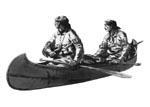

The
Bark Canoe Store
2317 West Fairview Avenue
Spokane, WA 99205
(509)327-7902
(509)327-7989
barkcanoe@earthlink.net
www.barkcanoe.com
John Lindman
proprietor/builder
IN THIS ISSUE
1. News
- Class Update
- Builders' Bulletin Board
2. Building Tip - Carving
Class Update
Two classes this year, both in September and both in Spokane, Washington.
One is 9 days and is the standard class where students work on one canoe -
the class canoe. The price is $695. Class starts September 4 and ends September 12.
Class size limited to 6 students.
The other class is where students build their own canoe. It is 14 days and
starts September 18 and ends September 25. The price for this class is $2250 and
includes the materials ready for assembly. Class limited to 4 students. (You can bring friends
to help you assemble your canoe at no extra cost. )
Both classes include a crooked knife, an awl, detailed notes and a copy of The Bark Canoes
and Skin Boats of North America by Edwin Tappan Adney.
OK so the page is up and we have a couple of photos. Keep sending them in. Also if you have a canoe that you would like to sell drop me a line. I have people looking for used canoes.
Click birchbark canoes to view this page.
Building Tip - Carving
The two essential skills for canoe building using traditional
methods is splitting and carving. Here are a few points that
might make carving easier.
First is your knife. It must be sharp and have a correct edge on it. The bottom of the knife must be flat. This is vital. The angle of the edge on top will determine the amount of wood that comes off at a time. The same principle as a plane. I spoke with Henri Vaillancourt one time and he told me he has two knives, one for removing wood and one for finish work. The former has a gradual bevel and the later a steeper bevel. Get the edge as sharp as you can. I use a file - some think I am nuts for doing so but it works for me. Some prefer a stone and even better a diamond plate. The point is that it should be sharp and cut effortlessly.
Next is the grain of the wood. If you find your knife hops at all yet it is sharp then you are going against the grain. The cardinal rule of splitting is split from the top of the tree down. The opposite holds true with carving. It is not as vital as with splitting and in some cases I have found it didn't work but for the most part carving is much easier going from the bottom of the tree up.
Shave the wood, don't whittle it. Ideally, shaving curls should be coming off. Of course there are times with cedar where you can remove large slices but the surest and most efficient way in my opinion is to not dig. Work the knife like a one hand plane.
The last tip is hold the knife so that your forearm runs parallel to the piece you are carving. An error often made is to hold the elbow away from the piece and carve with the tip of the blade. You lose control. You will find that when it all comes together you can carve without a lot of effort. You won't be holding the knife so tight and you will be able to move your fingers at the end of the day.
Hope it helps.
That's all for now.
----------
To remove yourself from this list, simply reply to this
email with the word "REMOVE" in the subject.
----------